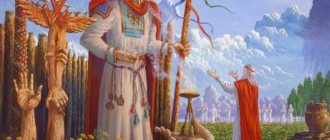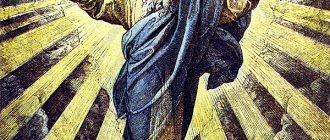Faith and knowledge, mysticism and reality, science and religion are concepts that argue with each other all the time that humanity exists. Most often, the first conflicts with the second, thereby creating a black-and-white coordinate system, where spirit is opposed to matter, a scientist is opposed to a priest, and one cannot intersect with the other by definition.
But in reality the picture is much more complex. Yes, religions are based on tenets and creeds that are accepted by default by their followers. But even in the academic environment there were and are their patriarchal luminaries, whose authority is sometimes as strong as that of the Old Testament prophets, and whose dogmas are undeniable - thus, the geocentric system of the world has remained unshakable for centuries. At the same time, churches more than once turned out to be a place for discussion, and religious law often contained not only strict regulations, but also consistent, rational polemics on a number of everyday issues.
Relationship history
The religious and scientific spheres of human life have interacted in different ways throughout history. Antiquity shows us rather their mixture, frequent complementation of each other, and only a few examples of opposition. The Middle Ages were a time of severe conflict, persecution and persecution of scientists. In modern times, the roles begin to change, and in the last century, adherents of religion were increasingly accused of obscurantism and were sometimes brutally persecuted. Nowadays, the situation has become more complicated - the relationship between faith and science has taken on many forms, where there is a place for conflicts, dialogue, and the mutual penetration of ideas and concepts.
Antique period
In the era of the very first civilizations of the Ancient East, we can already talk about pre-science - bringing existing knowledge into a system to solve pressing problems and tasks. An important role was played by clergy, as well as various kinds of healers: within the framework of astrology, the rudiments of astronomy began to emerge, and healing through trial and error laid the foundations of medicine.
At the same time, pre-science was almost entirely of an applied nature. The geometry of Ancient Egypt had great practical value as a set of guidelines for action, but it was not familiar with the concepts of theorem or proof.
However, already in Ancient Greece the situation begins to change:
- practical knowledge is combined with the first scientific methods;
- the concept of hypothesis is introduced;
- logical thinking is formed;
- Research techniques are systematized and classified.
The main role in these processes belongs to Aristotle. The Platonic Academy and the first scientific disciplines emerged, and Greek and Indian thinkers independently developed the foundations of the theory of elementary particles and the concept of the atom.
Rationalism versus magical consciousness and logic versus dogma are the two main signs of scientific-religious confrontation in the era of antiquity.
During the same period, atheism emerged as a form of worldview, and scientists began to be persecuted and even killed for criticizing religion. One of the first materialists, Heraclitus, rejects the idea of the creation of the world by higher powers and ridicules the worship of gods. The great medical scientist Hippocrates fiercely fought against magic and witchcraft, contrasting medical science with religious prejudices associated with the treatment of diseases. Aristotle was persecuted for his views, and Socrates was even executed on charges of blasphemy.
Middle Ages
The beginning of this period is often called the Dark Ages - a time of degradation in almost all areas of human knowledge, culture and art. This was the case in Europe.
But in the East things were different:
- The Arabs actively borrow the scientific achievements of the conquered countries, the ancient heritage is preserved and translated.
- Astronomy and mathematics are developing especially actively; the word “algebra” itself is of Arabic origin.
- In 970, Al-Azhar University, one of the oldest in the world, was founded in Cairo.
- Samarkand resident Ulugbek creates an observatory.
- The Iranian Ibn Sina writes medical treatises, alchemy develops.
Within the framework of Islamic theology and lawmaking, the Eastern school of philosophy is widely developing. Disputes are being conducted both about lofty matters and about completely earthly matters - for example, the interpretation of certain provisions of Sharia and their application. For this purpose, the Arabic language creates its own conceptual apparatus for the logical and analytical method.
In the Islamic world of the early Middle Ages, religious faith and scientific knowledge not only peacefully coexisted, but even complemented each other.
European medieval science for a long time dealt mainly with issues of theology; secular sciences fell into decline. However, within the framework of theology, scholasticism developed - a discipline where the religious-dogmatic approach was combined with Aristotelian logic. But in general, this period was marked by the absolute dominance of the religious picture of the world in society. Church ministers actively oppose scientific knowledge.
Since the 12th century, contacts with the Muslim world, the reconquest of Sicily and the Reconquista in Spain have returned to Europe the heritage of ancient science - now in Arabic translation. Scholasticism continues to develop, and a scientific community known as the Chartres School arises in France. Its participants tried to combine scientific methodology with Christian religious philosophy. In their works, the concept that the Universe, being created, develops independently according to the laws laid down by God, and man is endowed with reason and therefore can cognize the world around him, received final form.
Attempts by scholastics and natural philosophers to find a place for science in a religious view of the world met with harsh criticism from the church. The paths of religious ministers and scientists diverge.
During the Renaissance, this trend intensifies. Geographical discoveries and the invention of the printing press contribute to the accumulation and dissemination of new knowledge. In 1440, the treatise “On the Forgery of the Donation of Constantine” was published in Italy. This work proved the falsity of a document from the 7th century, which declared the primacy of church authorities over secular ones. The treatise was a model that laid the foundations for scientific and historical criticism, as well as philological analysis.
New time
During this period, a general turn began from a dogmatic and religious worldview to a scientific one. There is a tough struggle going on, the church accuses scientists of heresy, subjects them to persecution and execution - not only Catholics, but also “progressive” figures of Protestantism are zealous in this. Galileo Galilei is persecuted by the Inquisition, and Giordano Bruno and Miguel Servetus are burned alive at the stake. In 1559, the Roman Curia began to publish the “Index of Forbidden Books,” which included seditious scientific works under Catholic censorship.
A real revolution is taking place in scientific methodology. Previously, the main idea was the transfer and preservation of knowledge, the deductive approach prevailed - conclusions were drawn from a general or authoritative postulate to a particular conclusion. Logic was recognized as a more suitable tool than practical experience.
The inductive approach is from particular or experimental experience to a general pattern. He wins and becomes the main feature of modern science.
The laws of physics and mechanics are discovered, astronomy and medicine develop. In 1687, Isaac Newton published an epoch-making work entitled “Mathematical Principles of Natural Philosophy,” which outlined the foundations of classical mechanics and the law of universal gravitation. The book spurred interest in scientific knowledge and its popularization. The following 18th century became the Age of Enlightenment and was marked by the publication of many encyclopedias carrying a worldview that was already too different from the religious one.
Philosophy is separated from theology - now it is able to exist as a secular scientific discipline. The works of Kant and Voltaire are published, the sphere of influence of religion is steadily narrowing. More and more questions are arising to which the church, unlike scientists, cannot find an answer. Atheistic ideas are finding more and more fans.
Modernity
In the 19th century, science continued to crowd out religion in people's minds. Being a scientist is now a profession. New discoveries in the field of natural science make the world even more understandable in the eyes, there is more and more rational in it and less mysterious and mystical. But the main blow was dealt by the biologist Charles Darwin - his theory of evolution is officially recognized and directly jeopardizes the idea of the creation of the world.
Now the secular worldview is actively crowding out the religious, and the latter is often considered a sign of obscurantism and backwardness. Communist regimes in a number of countries openly promote atheism and persecute people for their religious views. The theory of evolution becomes part of the school biology course.
Science still cannot explain many phenomena. The emergence and development of the Universe, its boundaries, the possibility of an afterlife, the human soul as a substance - scientists cannot give unambiguous answers to these questions.
Today, scientific and religious approaches find different applications. In addition to militant atheists and orthodox believers who take biblical texts literally, there are enough people who fully believe in both God and science at the same time. In the new century, scientists and priests often find a common language.
Believing scientists: list of the most famous
What did prominent religious scientists say about God? Let us list the most famous Christian scientists who have lived in the last few centuries. That is, precisely when the religious picture of the world ceased to be obligatory and unique. People began to make their worldview choices more consciously.
Johannes Kepler . In his essay “The Harmony of the World,” the mathematician and astronomer Kepler addresses God:
“I thank You for all the joys that I experienced in contemplating Your works!”
Isaac Newton . He owns the words:
“The further a person penetrates into the secrets of nature, the more clearly the unity of the eternal plan is revealed to him.”
In an incredibly complex, but harmonious and harmonious living world, the physicist saw the work of a wise and powerful “ever-living Doer.”
Carl Linnaeus . When the naturalist and physician Linnaeus completed one of his studies, he exclaimed that it was as if an infinite and omniscient God had passed by him:
“I have not seen Him face to face; but the glimpse of the Divine filled my soul with silent wonder. I saw the trace of God in His creation...What wisdom! What indescribable perfection!”
Louis Pasteur . The chemist and biologist Pasteur admitted that he prayed during his research and was constantly amazed at the works of the Creator:
“I have studied a lot and therefore I believe like a simple peasant. If I became even more learned, my faith would become as deep and ardent as the faith of a simple peasant woman.”
Mikhail Lomonosov . The great natural scientist insisted on the benefits of a harmonious combination of science and faith. He called nature the Gospel, which solemnly proclaims the creative power, wisdom and greatness of the Lord.
Ivan Pavlov . The outstanding physiologist was a church-going Christian. He stated that, thanks to research, he was convinced of the existence of an immortal soul in man.
Max Planck . The famous physicist said that in religion God is the foundation, the beginning of all thinking, and in science - its end, its summit.
Such great scientists as Galileo Galilei, Robert Boyle, Antoine Lavoisier, Alessandro Volta, Michael Faraday, Charles Babbage, Max Born, and many others also declared their religious worldview.
Similarities and differences in the picture of the world
For many centuries there was no clear line between scientific and religious disciplines. The division into the spiritual and secular spheres of life and the boundaries between them is a later phenomenon. The church finally separated from the state only in the twentieth century.
Object and subject of knowledge
In ancient times, the role of religion was comprehensive - it was a source of knowledge about the world, a moral imperative, and the basis of a worldview. Scarce practical knowledge only complemented this picture. Now it is science that brings people knowledge about the world around us and its material phenomena.
For religion, the main question is the place of man in this very world and his relationship with higher powers. The fate of the soul during earthly life and after it, sin and virtue, reward after death and redemption are things that go beyond the scope of a materialistic view.
Goals and objectives
For a scientist, the goal is to study the world around us in its material aspect. New discoveries can thereby improve people's quality of life.
A church minister sees his task as saving the believer’s soul and ensuring its good afterlife and salvation from sin. The emphasis in everyday life is on moral issues.
Features of the study
The scientific approach is characterized by reliance on facts and experimental knowledge as a source, deductive, inductive and other methods of understanding reality. Initially, it is assumed that this or that fact or pattern can be reformulated, supplemented or even refuted.
The basis of a religion is a creed and a set of dogmatic postulates that its follower accepts by default. They cannot be revised or refuted, and the role of an authoritative source is the sacred text and decrees of hierarchs or theologians. But the discussion may well turn out to be appropriate, as in the originally religious science of scholasticism.
Points of contact
Both approaches are particularly common and interact in the fields of anthropology and psychology. Secular humanism, formed largely on the basis of the ideas of the Enlightenment, often intersects with Christian humanism. Methods of psychology and psychotherapy directly enter the field of religion, revealing the secrets of the human soul and raising questions about the meaning of life. At the same time, physicists and biologists are exploring the issue of life and death, without ignoring the religious experience of people.
“Our problem is that we have forgotten how to ask questions correctly”
“But nevertheless, many today argue that science deals only with the description of material objects.
- Not necessary. Take sociology, for example: it describes the virtual world of human interests and the struggle of subjects. Or psychology. We see the same thing in religious studies. It does not matter to a scientist whether a particular belief is true or not. Its task is to show how this religion was structured, what social realities it created, and how its ideological framework changed over time. Therefore, modern intellectual discipline requires that a scientist learn to clearly understand by what rules and on what field he is currently playing the game - in order to avoid erroneous interpretations. And I, as a scientist, will never tell my colleagues about my ideological sympathies. In the same way, in the religious field, scientific arguments, in my opinion, are simply inappropriate (unless, of course, they relate to confessional sciences).
- Why are they inappropriate?
- Let's give an example from another area. Imagine that a neuroscientist tries to explain some phenomena in the field of art using the language of science. Any poet or musician who reads such research will say to such a scientist: “Are you trying to explain creativity to me through the interaction of networks of neurons in my brain? But understand, neither I nor my listener or reader needs this. We are from another world where completely different rules apply.” Here is a clear example of an incorrect transition from one area to another. It may be useful for a scientist to conduct such research for his scientific field, but for a person of art this makes no sense.
Another example can be given. It is known that modern scientists are studying how religious worldview affects our brain. And it is clear that some kind of logical and biological relationship can be found. But for the most religious person, such a study will explain absolutely nothing. And if a scientist tries to convince him of something in this way, he will show his scientific incompetence. After becoming familiar with these data, a believer does not necessarily, relatively speaking, have to take off his cross.
It is clear, for example, that the famous mystical vision of the mathematician and philosopher Blaise Pascal (the exact content of which is unknown to us, although the thinker left his impressions of the experience in the form of a “Memorial” note) is due to the fact that he had a tumor in his brain. However, the presence of such an illness in Pascal in no way compromises what he saw. Because there are many patients, but Pascal is alone. It doesn’t matter at all what kind of “fuel” his consciousness ran on. Of course, scientific, psychoanalytic, historical, and social explanations of a particular phenomenon can be very useful. But here it is important to ask the question: what exactly do we want from these interpretations?
Imagine that you are writing text on a computer, and at some point a programmer will come up to you and ask: “Would you like, I’ll now explain to you how this text works,” and then demonstrate how certain electrical connections work in the computer, creating text picture on the screen. What will this give you personally in this case? Nothing. This information will be useful if your computer needs to be repaired, or if the text you type doesn't match what appears on the screen. Therefore, it is so important to pose the question correctly and not confuse one language of interpretation with another.
— Why, then, do people today constantly appeal to science as the ultimate truth?
— Such an appeal, it seems to me, is connected with problems in the media and information space. A person has read a book by one researcher, but does not know that there are many such scientists, that they are different and sometimes have different positions on the same problem, that they argue with each other. Such a person simply needs to be explained that, firstly, there are always communities of experts who constantly discuss with each other, and secondly, they need to be reminded that the effect must be explained by adequate reasons. What I mean? For example, the text that I type on a computer depends only on me, and not on the system unit. But the fact that my thoughts are displayed in the form of text on the screen depends on the computer.
The trouble with modern people, even educated people, is that they formulate the question poorly. But back in ancient Greece, the famous Socrates based his entire philosophical method on correcting the questions asked. He simply taught people to ask them correctly.
A modern person, formulating a question incorrectly, receives an appropriate answer to it. Of course, one can try to explain spiritual life using psychoanalysis, sociology or a material basis. This has its own benefits, but strictly scientific ones, which can be used exclusively within its field. Under no circumstances should you jump from one area to another. The most unpleasant thing about modern culture is that it has completely lost the sense of the border, upon crossing which you find yourself in another jurisdiction, where different laws apply. By the way, believers also have problems in this matter when they begin to adjust scientific truth to a religious view of the world. You should always be aware of these boundaries and be careful. This applies to both scientists and believers.
The place of religion in science
Sometimes the scientific sphere can acquire religious features - for example, such as a focus on dogma and a set of infallible statements, and also have its own unshakable authorities and “prophets”. Dialectical materialism created in Soviet times and some movements in the field of biology and agronomy had all the features of a scientific religion without God.
Religious movements in scientific disciplines
Creationism is a concept that seeks to substantiate the idea of the creation of the world and man by God and to refute the theory of evolution. She often uses scientific methodology and tools for argumentation, although materialistically minded scientists do not recognize these arguments.
Transpersonal psychology is a direction that arose as a result of understanding the mystical practices of different peoples and altered states of human consciousness through experiments with hypnosis techniques and psychoactive substances. It enjoys a certain popularity in the esoteric environment, but is interpreted critically by most psychologists.
Scientists' opinions on supporters and opponents of religion
Among the scientists themselves there were and are many believers - for example, the great physicist Newton was a deeply religious person. But in general, the scientific community is inclined towards a secular, atheistic or agnostic understanding of reality. However, some aspects may differ depending on the country and mentality.
The general opinion of researchers is that religiosity depends on the degree of development of society and the level of education, and this is a global trend. The United States stands apart here: in this very developed country, a very large percentage of people believe in God, regularly go to church and read the Bible, and these are not always poor farmers. At the same time, universities and the scientific community are the outposts of atheism and leftist beliefs. In the media and social media there is an acute ideological confrontation between them and devout conservatives from the American heartland.
Evolution of consciousness
At the beginning of the 20th century, British religious scholar and anthropologist James Fraser proposed a theory according to which humanity has three views of the world around us. According to his version, in society there is an evolution of thinking from lower to higher. First, humanity is characterized by magical thinking, then religious and, finally, a scientific .
If a person does not understand the relationship between the mechanisms and phenomena of the physical world, he makes the elements gods, and with the help of a sequence of primitive rituals and actions he tries to influence the world around him. This is magic. Religious thinking manifests itself as belief in supernatural forces by which the universe functions and which can be propitiated through petition (prayer) or sacrifice. And only scientific thinking gives the most accurate answer to the question of what phenomena and physical laws underlie our life, and, most importantly, how these laws can be controlled. Despite the fact that Fraser's views were criticized quite harshly, many people to this day consider scientific thinking to be the most preferable and most progressive. But is it?
The place of science in religion
Biblical stories have always attracted researchers. Linguistics, physics, biology, and archeology deal with the analysis of events, characters, and artifacts mentioned in the pages of Scripture. What some take on faith, others try to logically prove or disprove. Archaeological expeditions continue to search for the tomb of the family of Jesus Christ, the tablets of Moses, the fragments of Noah's Ark and scrolls with the texts of the apocryphal Gospels. Where dogma is enough for some, others need evidence. There are matters on which knowledge and faith are unlikely to easily agree.
An American scientist fears that the penetration of religion into the sphere of science and education may distort people's consciousness. About this in the video:










